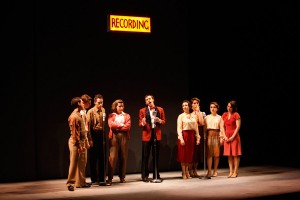Musical takes flight with stand-out performances
Film noir meets musical theater in the USC School of Theatre’s City of Angels, which premiered at Bing Theater on Thursday. As audience members take their seats in a theater only miles away from Downtown Los Angeles, they are eased back in time to 1947 Los Angeles, where cigarettes, femme fetales and sardonic jokes are in fashion.

Period piece · Film noir and musical theatre combine to create the perfect artistic hybrid in USC’s City of Angels. The dramatic production imbues the direction of the respected, talented John Rubenstein but it is the ensemble that truly shines, leaving no single stand-out performer. - Photo courtesy Craig Schwartz
“Everyone’s in a movie,” jokes Allen Darby who plays a sleaze ball movie producer only concerned with making his next buck. “Sometimes we just turn the camera on.”
This quote properly sums up City of Angels, which, considering the double-nature of the show’s characters and the blending between life on-and off-screen, seems funny and appropriate.
City of Angels follows the story of successful fiction writer Stine (Matthew McFarland) who attempts to combine his literary freedom with the intellectually unconcerned, money-making agenda of the 1947 Hollywood industry.
As Stine reworks one of his novels into a screenplay under the controlling influence of movie mogul Buddy Fidler (Allen Darby), he is forced to come to terms with the decline of his personal relationships as well as his crumbling identity.
Against all of this is the “fictional” world of Stine’s creations, where private eye Stone (Cole Cuomo), whose wise cracks, cigarette smoking and charming way with women mark him as the Phillip Marlowe of the theater world, investigates a missing person’s case that quickly becomes a murder story. As Stine writes Stone’s story, the real and the imaginary merge until the audience can no longer tell what is true and what is fiction.
The show is long, running just over three hours with a 15-minute intermission. But it manages to hold attention, provoke laughter and eye-rolling, even as it incites suspense.
Though the production features the talented influence of director John Rubinstein, who originated the lead role in Pippin and has directed many popular musicals, such as Into the Woods and Guys and Dolls, the cast refuses to be overshadowed. Every performer delivers powerful solos and emotive performances, making it difficult to pinpoint one crowd favorite or show-stealer.
Notable talents are Cuomo and McFarland, who, though polar opposites in terms of vocal style, complement each other as the duo of creator and created. Cuomo’s resonant baritone chills during his solo numbers and voiceovers — even his ordinary dialogue is pleasant to listen to. Lines like “Only the floor kept her legs from going on forever” have a certain ring in his deep tone of voice, turning the potentially cheesy into the comically appropriate.
Then there is McFarland’s tenor, which unabashedly soars to grasp sustained high notes. His frenetic energy carries him throughout tough numbers like “Funny” and “Double Talk,” and when he closes his eyes and belts out his final notes, viewers forget that they’re watching a performance.
The female leads are just as impressive. Though City of Angels features a series of likable but shallow female characters — they only seem to exist for the men around them — the USC actresses bring writer Larry Gelbart’s women to life. Alexandra Arthur’s fluid mezzo glides over high and low notes as Bobbi/Gabby, and Carrie St. Louis gives a flawless portrayal of the film-noir bombshell. Especially stunning is Amanda Holt as Oolie/Donna, whose rendition of “You Can Always Count on Me” is hilarious and vocally memorable.
Most of the cast members also double as characters in the real and fictional worlds, allowing the audience to clearly see the consistent emotional undercurrents between certain characters and understand where Stine gets his inspiration. This element of City of Angels provides food for thought for audience members who want to make connections between the show’s larger themes, and solid entertainment for those who just want to have a good time.
On top of the cast talent is the show’s slick production value, which makes use of a conveyor-belted stage to quickly make scene and set changes. Offices and hotel rooms slide on-and off-stage in a matter of seconds, reminding the audience of the quick scene jumps in the movie that City of Angels attempts to emulate. At one point in the show, a covered corpse on a gurney becomes a man getting a massage on a table — cute and effective.
The show’s design is also particularly exceptional. Specific detail is paid attention to costuming and props, and muted colors are used in the set design to emphasize the drab and usually grayscale coloring of noir films. If anything is historically inaccurate, the audience never questions it.
If not for the pleasant doubling of a show about Los Angeles performed on USC’s campus, it would be easy to see such a high-caliber production snagging a spot on Broadway or the West End.
At any rate, this college-level production remains a must-see.
City of Angels plays at the Bing Theater until April 7.
